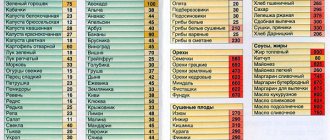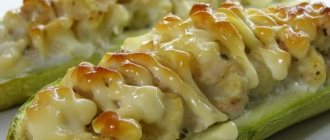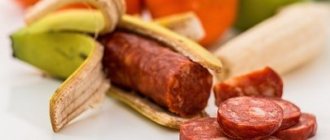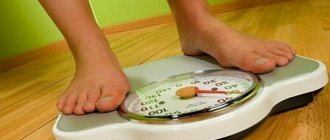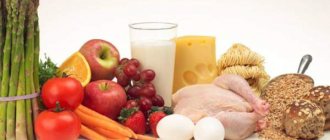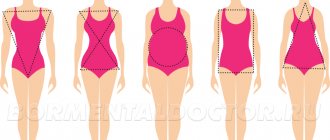The impulse diet was developed by the famous Russian nutritionist Mikhail Ginzburg, which automatically classifies it as an effective and harmless way to lose weight. The key point and basis of the nutrition system under consideration is fasting days. They are held every three to four days. It should not be consumed more often, since the body should not experience a lack of essential nutrients. True, there is a caveat here - you can do them every day, but these should be light breakfasts and dinners with a hearty lunch. Food intake throughout the entire period of the Ginsburg diet occurs at strictly regulated time intervals. However, these are not “hunger” restrictions, but only a reduction in fat consumption, and a significant one. The menu includes proteins and carbohydrates, vegetables and fruits).
The basis of the diet
Limiting fat consumption is the main rule on the basis of which Mikhail Ginzburg created the diet. The “ideal weight loss program” consists of changing your diet, and even without a significant increase in activity leads to gradual weight loss. It is designed for long-term use, therefore, despite limiting fats in the diet, they cannot be completely excluded, since without them a full exchange of elements in the body is impossible. Fats also help the absorption of many vitamins and control appetite.
Another prerequisite is to spend one or two fasting days every week. During these periods, you should not neglect nutrition completely, but switch to light vegetables, fruits and protein foods. However, this should be achieved gradually, observing certain rules on which Mikhail Moiseevich Ginzburg bases his methodology. Also, you cannot arrange more than two fasting days, since the body should not suffer from a lack of nutrition, vitamins and microelements.
What is the Ginsburg Diet based on?

The essence of the Ginsburg diet is special mixtures. However, when it is impossible to buy specially prepared food, it can be successfully replaced with lean varieties of meat or fish. This technique will allow you to stop fasting days for some time with the obligatory condition of following a low-fat diet. There will be no weight gain.
A person can get used to a certain diet and low-fat product in a small amount of time. Due to this, the metabolic process is aimed at losing weight, extracting energy from the body’s reserves. The nutrition system does not aim to limit the amount of food and calories, or avoid sweets. But it is worth remembering the limited amount of fat per day - no more than 40 grams. You should only consume foods with a calorie content of no more than 5%.
Exclude:
- margarine;
- oil;
- salo;
- fatty meat and dairy products;
- chocolate;
- cream;
- bakery.
The benefits of the Ginsburg diet are:
- safety;
- affordable low-fat foods;
- Strict control of calorie intake is not required;
- the possibility of using ready-made mixtures (if used); they can be worn to the office;
- reduction of fatty tissue, not muscle;
- weight loss gradually and evenly, which meets medical requirements;
- Using such a program is possible for a long time - up to 3 months - without significant harm to health.
The only minor drawback of the diet is a temporary deficiency of polyunsaturated fats. You can avoid this by simply including fish or fish oil in your daily diet.
Stages of nutritional change
To effectively and gradually reduce body weight, Mikhail Ginzburg in his methodology developed the following steps, following which will allow you to switch to proper nutrition without harm to the body:
- The first step is to study the theory.
- The second stage is the transition to a low-fat diet (duration from 1 month).
- The third step is normalizing sleep (full sleep is the best assistant in losing weight).
- A period of additional restrictions and active weight loss - the introduction of fasting days.
- Transition to a low-fat diet and normalization of body weight.

To lose weight safely, when going through these stages, you should not rush and quickly move on to the next period. The time for continuing each step is strictly individual, since the transition to the second stage is prohibited if the body is not yet accustomed to the nutrition at the first step, Mikhail Ginzburg points out in his book. The “ideal weight loss program” involves slow weight loss, only in this case it will not come back, and medicine all over the world is against accelerating fat burning. This is due to the fact that during emergency weight loss, the body experiences enormous stress, and after normalizing nutrition, it tries to make reserves. In this mode, uncontrolled weight gain occurs, even more than it was before losing weight. Therefore, it is very important to comply with all deadlines when moving to the next stage.
Mikhail Ginzburg - So how can you lose weight?
Before you make any efforts, think again, is it worth it? From a medical point of view, it is definitely worth it, especially if the weight exceeds the ideal by more than 25-30 percent, or if the bulk of the fat is located in the abdominal cavity. This is when the ratio of waist-to-hip circumferences in women is greater than 0.81, and in men it is greater than one. It is well known that timely reduction of excess body weight leads to normalization of blood pressure, sharply reduces the likelihood of developing myocardial infarction and, in a very large percentage of cases, normalizes blood sugar levels in diabetics. Why not get your weight in order?
But in other cases? For example, when your weight is more than you would like, say, 5-10 kilograms. I think it's worth it too. After all, this is, at a minimum, a tendency to be overweight and, if no measures are taken, the weight will increase. However, you need to be careful. There is fairly accurate evidence that incorrect actions in terms of weight loss increase the tendency to be overweight and then it will be increasingly difficult to cope with obesity. Why? Because during a diet, especially if it is chosen incorrectly, the body learns to spend energy more economically and begins to conserve it. That is, when a person loses weight solely for the purpose of improving his appearance, by the way, a goal that deserves respect, he must do everything right from the very beginning. Actually, it’s better to do everything right in any case.
How will be correct? If I tell you about this right away, many of you will not believe me and you will be right. The principle of my story is different. I prefer that my readers understand the essence of things, then they will easily understand the conclusions I have drawn. One thing is bad, the story from my reasoning becomes longer and, in some ways, boring. But believe me, the problem is worth it. I adhere to the same principle when working with patients. I can't treat them for the rest of my life. So my task is to teach them to understand the problem of excess weight, to be able to prevent weight gain, and to be able to reduce it. This is the only way they can help themselves. And further. Excess weight is often a family problem. Some people are already fat, others are still only inclined to be overweight. And if my patient is from such a family, I advise her to reconsider the diet in the family. Then her husband will slowly lose weight, and her children may never gain weight.
Therefore, let's first talk about what weight loss methods generally exist. Let's discuss them slowly. I'll tell you what I like about them and what I don't. And so, little by little, we’ll get to the point.
And further. Now in any pharmacy you can buy at least 5-6 products that are written to help you lose weight, and each one says that it is the only one that helps. Turn on the TV. There is an abundance of advertisements for various kinds of exercise machines and massagers, which, as they say, are one hundred percent effective and exclusively effective. Any newspaper, any magazine, especially one intended for women, will definitely write about how to lose weight. There are 15-20 pieces of advice, such as: eat slowly, chew everything thoroughly, don’t eat at all after 6 pm, eat meat and pasta separately, and so on. How to figure it all out? How to separate effective tips, tools and methods from ineffective ones? After all, you must admit, if all these methods helped, there wouldn’t be so many of them. And the problem itself wouldn’t exist.
Let's remember once again what we are dealing with. A person has overdeveloped energy reserves in the form of adipose tissue. The only way to get rid of these reserves is to use up fat, that is, create a situation where the body will be forced to burn this fat. Fat cannot be evaporated, released using diuretics or laxatives* and, strictly speaking, cannot be burned using any medicine. And the idea that you can lose weight, and therefore use up excess fat, only by spending it on the body’s energy needs and that there is no other way, I would like to formalize it in the form of a rule.
It has been established, and I have already written about this, that the body consumes its own fat last. First, sugars that enter the bloodstream directly from food are consumed, then carbohydrates accumulated in the form of glycogen in the liver and muscles. Their supply is small, no more than one fifth of the energy required for the day. Next, the body uses up the fat and proteins it eats, and only fourthly the fat from its fat reserves. How to change the situation, how to make the fourth stage the first, or at least the second? The most logical thing is to change the diet so that the content of fat and carbohydrates in it would be minimal, then the body, quickly picking up glycogen reserves, will start using its own fat and the person will begin to lose weight.
However, this is where the main problems begin. And the first of them is the feeling of hunger. As we said above, the body does not react with increased appetite or hunger to the absence of fats in food, but it does react, and sometimes even very significantly, to the absence of carbohydrates. I have seen cases where hunger simply changed people's mood and behavior. They became aggressive or depressed. Sometimes dizziness and headaches appeared. In any case, hunger is what most often frightens and stops most of those who want to lose weight. Hunger is what makes patients stop treatment early.
Hunger is a completely natural reaction in this case. People tolerate it differently, and from my own experience I can say that it is most difficult for people with mental work to tolerate. This is explained simply. The most sensitive organ to the lack of carbohydrates is the brain, because this organ feeds exclusively on glucose.
The feeling of hunger depends on many reasons, and even in the same person with the same nutritional state, it can be different under different conditions. Have you noticed that, for example, urgent work or an interesting conversation, and you literally forget about food for several hours? Another example. Many people under stress completely lose their appetite.
Often my patients decide to start losing weight precisely under the influence of stress. The man looked at himself in the mirror and found his reflection unpleasant and shapeless. Stress. The decision was made to lose weight. He knows that he will be hungry, but he will endure. He's angry with himself. Stress. And he endures. And it very often happens that sensations of hunger, if they arise, are much smaller and milder than he expected. There is a very specific mechanism for this phenomenon, namely, suppression of appetite under stress*. Under stress, the activity of adrenaline and norepinephrine increases in the brain. These hormones depress the appetite center in the brain.
Here, perhaps for the first time, I introduce an idea on which I will continue to insist. A person cannot lose weight all the time. It cannot for objective and subjective reasons (more on them later). That's why. You need to start losing weight with the appropriate mindset. When this attitude disappears, and it most often disappears long before body weight normalizes, you should switch to a regime that prevents weight gain. Now you know how not to gain weight. The entire previous chapter is devoted to this issue. After some time, a very specific desire to lose weight further will appear again. And for some time you will again lose weight.
Now let's talk about what to do about hunger. The simplest thing is to endure. There are several scientific papers that specifically examined the sensations of hunger during ongoing fasting. It turned out that with a complete refusal of food, the feeling of hunger first intensifies, reaching a maximum at the end of the third day, and then begins to decrease and by the end of the fifth or sixth day it decreased almost to zero. But temptations remain. Imagine, you are starving, and they eat something delicious in front of you.
Another solution. Feelings of hunger can be reduced by eating large quantities of low-calorie foods. For example vegetables. Let me give you an example. The calorie content of cucumbers is 8-10 calories per 100 g. That is, even if you eat two kilograms of them, in energy terms it will be only 200 calories. The same amount is contained in 80 g of white bread. Now tell me what is easier? Spend a fasting day on two kilograms of cucumbers or 80 g of white bread? Here is also an important digression. It turns out that the satiety of foods and their calorie content are far from the same thing. Example? Please. The calorie content of a glass of sweet tea is usually no more than 50 calories. 50 calories is 5 grams of vegetable oil - one teaspoon. Tell me, what will fill you up more, a glass of sweet tea or a teaspoon of vegetable oil? In descending order of saturating effect, all products could be divided into 3 groups*:
- Products with a high satiating effect - easily digestible carbohydrates (sugars), starches (bread, pasta, cereals), some fruits (bananas and citrus fruits)**
- Products with an average satiating effect - protein products - meat, fish, cottage cheese, eggs, milk and fermented milk products, most vegetables and fruits
- Products with a low satiating effect - sour cream, various oils, fats.
So, the feeling of hunger can be reduced by choosing the right foods. By the way, as for Doctor-slim, which I already wrote about, it can be classified as a product with a high saturating effect. 100 calories in the form of Doctor-slim, this is half a liter of a standard prepared drink. This amount can satisfy everyone.
And finally, all restrictions associated with the diet are much easier to bear if the diet is prescribed in a pulse mode. For example, fasting days alternate with regular ones. Then the necessary prohibitions apply only for this day, and tomorrow everything will be possible again. Or even simpler. During one day, the patient is given fasting meals in three doses and for one meal (lunch or dinner of his choice) he eats regular foods. Provided that these foods are mainly lean, a completely satisfactory weight loss effect will be observed. You see that in this case, even for one day you won’t have to endure or forbid yourself anything.
Psychotherapists can suggest quite a few ways to solve appetite problems. For example, this: “The feeling of hunger is pleasant for something, it’s pleasant to feel how old reserves of such fat that you hate are burning inside you. You just need to be patient a little and your body will acquire a new quality. A beautiful figure, health, a feeling of victory over oneself, what could be more beautiful?!” Or. “When I’m hungry, I cleanse my soul, I discover new possibilities in myself, it turns out I can tolerate inconvenience, which means I’m a strong-willed person.” And so on. The psychotherapist tries to find the psychological reasons that led to weight gain. For example, this is the reason. Food is definitely a pleasure. One of the pleasures. But it may happen that there are few or no other pleasures - boring work, boring life... And then the role of food increases, a person begins to eat more, tastier and fattier. Of course, this can promote weight gain and prevent weight loss.
Using a series of conversations, hypnosis and some other influences, a psychotherapist can eliminate or reduce the influence of psychological preconditions for excess weight and thereby enhance the effect of treatment. I would like to emphasize that there will be success only if the doctor works with each patient individually. Real psychotherapy has nothing to do with “coding.”
A typical coding session is held in a room. From 20 to 50 people are exposed at the same time. And even more. It is clear that there can be no talk of any individual approach. The session begins with a story about the diet that must be followed. Usually it's just a half-starvation diet (you see - another diet). Next, the actual “psychotherapeutic” action. Patients are asked to close their eyes, make certain passes over their heads with their hands, or touch their head with anything. That's it, you are coded. If the patient believes that witchcraft has happened, he will follow a diet and therefore lose weight. If he doesn’t believe it, then he doesn’t follow the diet and, accordingly, doesn’t lose weight. I am not inclined to criticize anyone in particular in my book. Perhaps those doctors who practice coding sincerely believe in its effectiveness and safety. I won't argue. After coding they lose weight. True, only if you follow a diet. And those factors that I condemn may just have an effect. You come to the hall. There are a lot of people like you out there. They came, which means they believe. You involuntarily begin to believe. This is the so-called indirect psychotherapy...
Better yet, let me say a few elementary truths for any doctor and you will understand what I don’t like about coding.
Working with a patient in any field of medicine can only be based on an individual approach. This work may also include interventions in a group of patients, but only as a stage or element of overall work and only if the doctor can control each group member.
An ill-conceived diet can harm the patient’s health. Which one we will discuss in detail below. A way to avoid this is to prescribe a diet that is thought out from a medical point of view, firstly, and select it strictly individually, secondly.
During the treatment of excess weight, as a rule, it is necessary to revise the diet, making it either softer or stricter. Other assignments have to be changed as well. This completely eliminates the possibility of curing the patient in one session.
After treatment is completed, it is necessary to follow certain dietary guidelines to prevent weight gain. If the patient is not aware of these principles, his weight will return to or exceed the original level after some time. Apparently it is no coincidence that most of the patients who now come to me for treatment in the past have either been coded, often several times, or used other fashionable methods of self-medication.
But the feeling of hunger, unfortunately, is not the only problem facing those who want to lose weight.
Another problem is undesirable changes in metabolism and lifestyle that usually occur while following a diet.
As soon as a person begins to cut back on food and switches to diets with lower calorie content, his body tries to spend less energy, save it, and hide it.
In other words, you are trying to eat less, and he is trying to spend less. And, as practice shows, he succeeds quite well. Judge for yourself. Typically a person spends about 2500-3500 kilocalories per day. It seemed that it would be possible to prescribe him a diet with a calorie content of 2000 kilocalories. Small deficit. He won't even notice. In reality it will look like this - everything is possible, but about one quarter less. And live for yourself. It will take from 50 to 150 g of fat per day to cover the energy deficit. For a month - 1.5-4.5 kg, for a year 15-35 kg. Why not solve the problem? However, it doesn't work. 2-3 weeks will pass and the person will no longer spend 2500-3500, but 2000 calories and will stop losing weight. This phenomenon is probably familiar to many of you. You follow a diet and at first everything goes well, the weight decreases, but after some time the weight loss stops despite continuing to follow the diet.
Moreover, it is quite difficult to notice a decrease in energy consumption. This may be expressed in a slight decrease in body temperature. On average by 0.2-0.3 degrees. It's getting a little colder. So what, the person starts to dress warmer and everything is fine again. The heart's work slows down somewhat, blood pressure decreases, the person begins to sleep longer and deeper, and calms down. It would seem that what's wrong with this? But these are external manifestations of a decrease in energy consumption. Or more. A person becomes lazier, gets tired faster, tries to move less, and even performs his usual work more sparingly. Indeed, a decrease in energy expenditure while following a diet is a problem that negates all efforts to maintain this diet.
How to solve it?
Firstly, take care of yourself, don’t let yourself calm down, come up with activities, do exercises. And let me emphasize, not training, but exercise. I’ll tell you about the difference between the first and second later.
Massage and shower have a good tonic effect. The shower can be contrasting. This is when the water temperature during the procedure changes from cold to hot and back. By the way, it has been quite accurately established that cold and, in particular, cold water clearly enhances fat oxidation.
I usually advise my patients to dress lightly, including at night. You need to spend more time outdoors and ventilate your apartment. After all, oxygen is necessary for fat burning.
The course of metabolic processes can be enhanced by special means that have a tonic effect. Among the well-known ones are ginseng, Chinese lemongrass, and eleutherococcus. But a doctor must prescribe and recommend them, since in some situations, for example, with concomitant hypertension or coronary heart disease, they are undesirable or require special dosing.
However, the problems are not limited to slowing down the body’s metabolic processes. There is at least one more. These are metabolic disorders associated with a lack of a number of absolutely essential components in food. Which ones? Primarily protein, as well as vitamins, minerals and dietary fiber.
If this problem did not exist, then the simplest and most effective way to treat excess weight would be fasting. Against the background of special means that limit appetite, fasting can be made relatively easily tolerated. But fasting is quite a harmful thing, primarily because it naturally develops a deficiency of vital food components. When fasting, the body primarily uses protein rather than fat. This is accompanied by skin defects, sagging, wrinkle formation, general and muscle weakness. The feeling is that in one day of fasting a person ages by one year, and in two weeks, respectively, by 14 years. Fasting is very difficult for a person to bear, and if the patient sees fasting as the only way to fight extra pounds, then having tried it once and failed, he will not soon decide to repeat this experience.
A common thing for fasting is the development of immunodeficiency or a state of insufficiency of our immunity. Immunity is also based on the constant reproduction of special cells or on the production of special protein molecules - antibodies - by these cells. It is clear that with a deficiency of protein in food, these functions suffer. As a result, the likelihood of various types of infections and colds increases.
It is also impossible to limit the intake of vitamins into the body - food factors that the body itself cannot synthesize, but whose presence is very urgently needed. Moreover, some vitamins, in particular B1 and B6, are actively involved in the oxidation of fats. Their deficiency will definitely affect the rate of weight loss.
I already wrote above about omega-3 polyunsaturated fatty acids. They can also be classified as essential food factors, since the body itself does not produce them. These acids are involved in the construction of cell membranes, and if they are deficient, a wide variety of metabolic and cellular dysfunctions can occur. The usual need for them is about 1-3 grams per day. The foods richest in them are fish and fish oil.
It is desirable that the diet contains a sufficient amount of dietary fiber. They retain excess sugars and fats in the intestines, preventing their absorption, and normalize intestinal function. Dietary fiber is found in vegetables, fruits and berries. There is a lot of fiber in wheat and rye bran (up to 40 percent), as well as in products containing it, for example, bran bread. Naturally, during fasting there is no need to talk about any fiber. The most common manifestation of a lack of fiber in food is quite severe constipation. I think this is familiar to many who have fasted to lose weight.
The usual scheme of fat breakdown necessarily includes an intermediate stage where ketone bodies are formed - acetone and others. If there are a lot of them, and during fasting their number increases significantly, then intoxication of the body occurs, which primarily affects the brain, liver and kidneys. This state of poisoning by ketone bodies during fasting has a special medical term - fasting ketosis. In mild cases, it manifests itself as fatigue, headache, and difficulty concentrating. In more severe cases - drowsiness, nausea, vomiting, palpitations, muscle tremors.
So, fasting is a voluntary refusal of a number of vital things contained in food and therefore a harmful thing. In fact, during fasting, the body eats itself.
Fasting with the use of mineral water and tablets containing vitamins and microelements is somewhat less traumatic. However, even in this case, a very undesirable protein deficiency develops and the body, under conditions of this deficiency, is mistaken for its own proteins. Muscle tissue, skin, liver cells, kidney cells, and cells responsible for immunity are consumed. It has been clearly proven that under fasting conditions the body is more susceptible to colds and infectious diseases.
Of course, under fasting conditions, weight decreases much faster than when following any diet, but almost half of this decrease is due to a decrease in muscle mass and other protein tissues. It is estimated that per day of fasting the body consumes from 100 to 200 g of protein. Accordingly, per month - from 3 to 6 kilograms.
For the reasons listed above, in the West, fasting as a method of treating excess weight has been practically abandoned. We still have it here and there. We lag behind Western countries in many ways, including in understanding the true mechanisms of excess weight gain and methods of treating it. You may ask, how can this be? And popular ideas that talk about fasting as the best and most universal treatment. What can I say? Unfortunately, this is natural. There is a kind of pseudo-medical environment around medicine, where various kinds of healers try their hand at treating sick people. Moreover, all ideas emanating from there usually claim to have a universal effect, that is, they promise help to everyone and from everything. There have already been so many such ideas and how many more there will be. Those of you who are older probably remember how in the mid-60s they wrote about the healing effects of vegetable oil. It was supposed to suck the oil. Relatively recently, about ten to fifteen years ago, society was captured by the idea of living and dead water. And then many people had devices for producing these waters at home. Then there was just a fireworks of ideas - cleansing the body with enemas, therapeutic fasting, urine treatment...
All these ideas have one feature - they have never undergone and never would have undergone rigorous scientific analysis. This fully applies to various types of “therapeutic” fasting techniques. Scientific control assumes the following. A group of subjects is taken. The influence under study is applied to them. Positive and negative aspects are recorded and then an analysis is carried out, from which conclusions follow whether this effect is suitable for treating a given disease or not and whether it is superior to existing treatment methods. So, with regard to fasting as a method of treating obesity, Western scientists have made an unequivocal conclusion in this regard - fasting has many negative aspects and, because of this, loses to well-constructed diet therapy.
I have been saying something for a long time about diet as a necessary component of treatment. Some of you may object, wait a minute, maybe it’s possible without a diet at all? After all, some products are now being advertised, various kinds of fat burners, bromelain and some others, the annotations to which say that they help without any diets. Just take one tablet three times a day and that's it. And a loss of 5-8 kg per month is guaranteed. To put it mildly, this is not entirely true. Some of these products were tested at the clinical nutrition clinic of the Institute of Nutrition of the Academy of Medical Sciences of the Russian Federation, and I saw the protocols of these tests with my own eyes. So, the results obtained showed the following. The use of “fat burners” without a diet is practically ineffective. Their use along with a diet adds another 10-15 percent to the results of the diet, but not for everyone. That is, if a person, following a diet, would lose 5 kilograms in a month, then when combined with a fat burner, he would lose 5 and a half kilograms. That's all? and that's it!
And again, some of you may object to me: “How can this be? A friend of mine is now taking one of the fat burners and has lost 5 kilograms in three weeks.” So what? Sometimes excess weight decreases simply because a person pays attention to it. Taking a drug that costs $60 for a monthly course, a person involuntarily begins to adhere to a diet, at least he will eat less. At the same time, some people actually succeed in losing 5-6 kg, especially if the excess is 20-30 kg or more, but no more than 15 patients out of a hundred. But how to maintain this result? The statistics are not reassuring. After stopping the course, the weight of those who have lost weight is restored over the next 3-6 months.
So, diet remains the only serious and absolutely necessary aspect of the treatment of excess weight. And there is nothing special about it. You can’t do without a diet for almost any disease, not just for being overweight. Diet is needed for peptic ulcers, hypertension and diabetes; it is also necessary for overweight. Another thing is, what should this diet be like?
Sleep and additional stress
Mikhail Moiseevich Ginzburg identifies adequate sleep and physical activity as additional assistants in normalizing body weight. Well, with an active lifestyle it’s clear - the more calories we spend, the more effective weight loss. Although here, too, Mikhail Ginzburg emphasizes weight loss as health improvement, and excessive loads are in no way applicable to achieving your goals. During training, it is very important to monitor your well-being, breathing and pulse. The intensity of the load is chosen optimally if the pulse rate is within 110-120 beats per minute, breathing is free and even, and the body does not experience fatigue. A good indicator of a well-chosen workout is the ability to maintain a casual conversation while doing the exercises.

Scientists in the field of weight loss have conducted several studies on the effect of sleep on a person’s weight, and they have shown striking results - all other things being equal, the effect of weight loss and the absence of weight gain was most noticeable in individuals who had full and prolonged sleep. On the contrary, the absence of this condition led to overeating and decreased physical activity, and, as a result, weight gain.
What does "impulse" mean?
The author of this system is Doctor of Medical Sciences, famous Russian nutritionist Mikhail Ginzburg. She is certified as a cardiologist, endocrinologist, psychiatrist and psychotherapist. To this day, he continues to publish books dedicated to correcting excess weight and maintaining normal weight. Particularly popular is his practical guide “Down with Diets!”, in which he describes in detail what a pulse diet is.

Practical guide by Dr. M. Ginzburg “Down with diets!”
It is based on alternating 2 nutrition modes: maintenance and unloading. Their tasks are completely different, which ensures the emergence of impulses for intensive weight loss with its subsequent maintenance. The nutritionist himself compares such a system with a staircase leading down (to weight loss): you lost a couple of kilograms (went down a step) - you fixed yourself (stood on it for a while) - and so you need to go down until the numbers on the scales satisfy your ambitions.
Maintenance mode
Involves compliance with 10 “wonderful” rules (given below). Moreover, you cannot force yourself to adhere to them through force: this way of life must be accepted and loved, otherwise there will be no results.
Unloading mode
You can move on to it only after you have fully mastered the supporting one. The goal is to minimize daily calorie intake without suffering or discomfort. Ginsburg suggests using dietary modifiers for this - weight loss cocktails. In his book, such a one-day fast is called a “fasting midday”, since dinner is not excluded.
10 “wonderful” rules
Ten rules that Ginsburg called “wonderful”, as they allow you to make food less fatty and high in calories while fully maintaining satiety and taste. These are the basic principles of his diet.
- Reduce the fat content of products as much as possible (methods are described in the “Recommendations” section).
- Reduce your consumption of sweets.
- Do not give up your favorite treats (cakes, sweets, chocolate, chips, etc.), but eat them after dinner, on a full stomach, stretching out the pleasure - this way the amount of food eaten will be minimal.
- Make multi-component dishes: put on a plate a small piece of chicken, a spoonful of buckwheat, chopped half of a baked potato, a little lecho and green peas, sliced vegetables on Iceberg leaves. According to Ginsburg, this restaurant approach to food will make meals more nutritious.
- Tasting dishes - trying every slice and enjoying the taste.
- Make meals frequent (up to 8 times a day).
- Reduce portion sizes.
- Increase your consumption of foods containing dietary fiber.
- Follow the pre-meal rule: 15 minutes before the main meal, eat something (a slice of bread, a slice of apple, a plum) to curb your appetite.
- Reduce alcohol consumption.
Ginzburg addressed his diet to the following categories of the population:
- children and teenagers;
- pregnant women;
- nursing mothers;
- office workers leading a sedentary lifestyle;
- for those who are actively involved in fitness.
Since the pulse diet offers a balanced diet and gradual weight loss, it has virtually no contraindications. Diabetics (sweets are not prohibited) and people with kidney failure (on fasting days the condition may worsen) need to be careful.
Before losing weight, it is recommended to consult a doctor. Or write to M. M. Ginzburg himself, whose contacts are on many sites.
Duration of ideal weight loss
The general course from the beginning of the transition to a low-fat diet, through a period of intensive weight loss and to normalization of body weight should be at least three months. In general, Mikhail Ginzburg does not highlight the concept of when to use an ideal diet, since each organism is individual, and the transitions between weight loss steps are very different for everyone. The main rule is that you cannot step over stages or shorten them if the body is not yet ready for this.
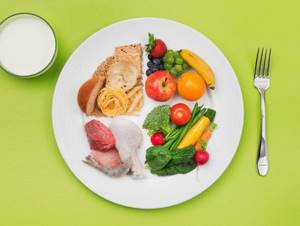
You can choose the right time to start the next step by carefully listening to your body - the nutrition of this stage is already becoming habitual, there is no desire to “break out”, and physical activity brings pleasure. If these parameters are met, it’s time to move on.
Recommendations

The tips below are taken from Ginsburg's book, Down with Diets!
BJU ratio
The amount of protein foods and foods containing dietary fiber in the diet cannot be reduced. Ginsburg offers 6 ways to reduce fat in your diet:
- Eat more lean foods: replace meat with fish and milk, do not add fried foods to soups, give preference to boiled and stewed dishes rather than fried ones.
- Use less fatty products among analogues: take low-fat cottage cheese, not 9%, dumplings - without adding lard, light mayonnaise, etc.
- Reduce the fat content of the dish during its preparation: remove fatty layers from the meat, use a minimum amount of oil for frying, skim the foam from the surface of the broth.
- Gastronomic trick: reduce the fat content of the dish while eating it: cut off the fat from the meat, remove the skin from the chicken, do not put mayonnaise or sour cream in the soup.
- Hedonic technique: eat fatty foods as slowly as possible, prolonging the pleasure - this will ensure faster satiety, which means the size of the portion eaten will be minimal.
- Information technique: carefully read food labels at the stage of purchasing them and choose the least fat ones.
A clear example of how the second technique works as part of a pulse diet:

Cocktails
As part of the maintenance regimen, weight loss cocktails should be drunk 15 minutes before main meals and instead of lunch and afternoon snack (5 times in total). Moreover, Ginzburg does not insist on their mandatory use, leaving the right of choice to its users.
Fasting afternoons - know-how diets. Since the main process of spending fat reserves occurs during the day, you should fast until dinner. Before it you need to have time to drink about 4 servings of cocktail. But in the evening you can allow yourself some low-fat foods. If you really want to eat during the day, do not deny yourself vegetables (but no more than 800 g) and bread (3-4 pieces).
Scheme of the fasting regime of the day according to Ginzburg:

A serving of a cocktail is required 15 minutes before dinner - this will help reduce your appetite. Before going to bed, you can eat an apple or a bun.
Ginsburg recommends using Doctor Slim cocktails, but does not insist on this particular brand. He gives advice on how to choose the right and healthy drink that is suitable for his diet:
- Buy only in pharmacies.
- Per 100 g of dry mixture there should be a maximum of 10 g of fat.
- For 1 g of protein - no more than 1.5 g of carbohydrates.
- Don't chase expensive brands.
Other cocktails for weight loss: homemade / pharmacy.
Sport
Ginsburg says his diet does not involve intense training. He suggests replacing them with healthy walking, which:
- is not as stressful for the body as running;
- consumes energy released from broken down fat;
- uses most muscles;
- allows you to easily dose the temp.
As an alternative he suggests:
- cycling;
- skiing;
- aerobic exercise equipment;
- simple exercises that can be easily performed at home;
- walking up the stairs;
- Nordic walking;
- health running.
Possible meal schedule

Approximate diet at stages
The low-fat step involves limiting the consumption of fatty meats, lard and oils. Preference is given to lean varieties of fish and meat. It is advisable to consume foods containing complex carbohydrates - cereals, pasta, and dairy products. Be sure to eat vegetables and fruits. This stage does not exclude sweets - however, it is best to use low-fat varieties - marshmallows, marmalade, marshmallows. Eating at least four times a day.
The active weight loss step involves additional restriction of carbohydrates, and sweets are completely excluded. The menu includes a mixture of low-fat cottage cheese and fruit, which must be consumed every day. The daily diet includes vegetables and fruits in their various forms, boiled meat, and fish.
The stage of introducing fasting days involves returning to a low-fat diet according to the first step, but with the introduction of fairly strict restrictions for two days a week. During these periods, you should consume a mixture of cottage cheese and fruits, raw vegetables and natural juices. You can drink tea or coffee (without sugar) in any quantity.
And most importantly, notes Mikhail Ginzburg, the body should not feel discomfort - performance is maintained, thoughts are clear, and the desire to normalize body weight does not disappear anywhere! To comply with these conditions, you need to set realistic goals for yourself, and understand that losing 10 kilograms in a month without harming your health is impossible, but gradually losing 3-4 kg of weight is an entirely achievable result.
Authorized Products
The impulse diet of Mikhail Ginzburg includes in the diet:
- Bran/grain bread or crackers.
- Lean red meat (beef/veal), rabbit or poultry.
- Chicken/vegetable broth soups with the addition of whole grains, potatoes and other vegetables.
- Sea/river fish (pink salmon, herring, pike perch, cod, pike, carp, hake), seafood (squid, mussels, shrimp), seaweed.
- Porridge, mainly from whole grains (buckwheat, oatmeal, millet), brown rice, pasta made from bran flour, egg whites.
- Fermented milk products whose fat content does not exceed 1% or are completely fat-free.
- Cold-pressed vegetable oil (olive) - 2 dessert spoons per day.
- Vegetables in raw form and vegetable-based dishes (salads/vinaigrettes), seasoned with lemon juice or vegetable oil.
- Fruits, various nuts and seeds.
- Sweets include marmalade, marshmallows, honey, marshmallows, brown sugar (up to 30 g per day).
- Fruit and berry juices, preferably with pulp (tomato, plum, apple, pomegranate), green and herbal tea without sugar, rose hip decoction, still mineral water.
Table of permitted products
| Proteins, g | Fats, g | Carbohydrates, g | Calories, kcal | |
Vegetables and greens | ||||
| greenery | 2,6 | 0,4 | 5,2 | 36 |
| squash caviar | 1,2 | 7,0 | 7,4 | 97 |
| zucchini | 0,6 | 0,3 | 4,6 | 24 |
| broccoli | 3,0 | 0,4 | 5,2 | 28 |
| cauliflower | 2,5 | 0,3 | 5,4 | 30 |
| carrot | 1,3 | 0,1 | 6,9 | 32 |
| cucumbers | 0,8 | 0,1 | 2,8 | 15 |
| beet | 1,5 | 0,1 | 8,8 | 40 |
| soybeans | 34,9 | 17,3 | 17,3 | 381 |
| tomatoes | 0,6 | 0,2 | 4,2 | 20 |
Fruits | ||||
| apricots | 0,9 | 0,1 | 10,8 | 41 |
| oranges | 0,9 | 0,2 | 8,1 | 36 |
| watermelon | 0,6 | 0,1 | 5,8 | 25 |
| cherry | 0,8 | 0,5 | 11,3 | 52 |
| grapefruit | 0,7 | 0,2 | 6,5 | 29 |
| pears | 0,4 | 0,3 | 10,9 | 42 |
| lemons | 0,9 | 0,1 | 3,0 | 16 |
| tangerines | 0,8 | 0,2 | 7,5 | 33 |
| nectarine | 0,9 | 0,2 | 11,8 | 48 |
| peaches | 0,9 | 0,1 | 11,3 | 46 |
| pomelo | 0,6 | 0,2 | 6,7 | 32 |
| plums | 0,8 | 0,3 | 9,6 | 42 |
| feijoa | 1,0 | 1,0 | 11,0 | 49 |
| cherries | 1,1 | 0,4 | 11,5 | 50 |
| baked sweet and sour apples | 0,5 | 0,5 | 12,3 | 59 |
Berries | ||||
| strawberries | 0,8 | 0,4 | 7,5 | 41 |
| strawberry | 0,8 | 0,4 | 7,5 | 41 |
| gooseberry | 0,7 | 0,2 | 12,0 | 43 |
| raspberries | 0,8 | 0,5 | 8,3 | 46 |
| currant | 1,0 | 0,4 | 7,5 | 43 |
Mushrooms | ||||
| mushrooms | 3,5 | 2,0 | 2,5 | 30 |
Cereals and porridges | ||||
| buckwheat | 4,5 | 2,3 | 25,0 | 132 |
| oatmeal with water | 3,0 | 1,7 | 15,0 | 88 |
| wheat bran | 15,1 | 3,8 | 53,6 | 296 |
| rye bran | 11,2 | 3,2 | 32,0 | 221 |
Bakery products | ||||
| whole grain bread | 10,1 | 2,3 | 57,1 | 295 |
Dairy | ||||
| skim milk | 2,0 | 0,1 | 4,8 | 31 |
| kefir product bio balance 0% | 3,2 | 0,1 | 4,5 | 32 |
Cheeses and cottage cheese | ||||
| cottage cheese 0% (low fat) | 16,5 | 0,0 | 1,3 | 71 |
Meat products | ||||
| lean beef | 22,2 | 7,1 | 0,0 | 158 |
| rabbit | 21,0 | 8,0 | 0,0 | 156 |
Bird | ||||
| boiled chicken breast | 29,8 | 1,8 | 0,5 | 137 |
| boiled chicken drumstick | 27,0 | 5,6 | 0,0 | 158 |
| boiled chicken fillet | 30,4 | 3,5 | 0,0 | 153 |
| boiled turkey fillet | 25,0 | 1,0 | — | 130 |
Eggs | ||||
| hard-boiled chicken eggs | 12,9 | 11,6 | 0,8 | 160 |
Fish and seafood | ||||
| boiled fish | 17,3 | 5,0 | 0,0 | 116 |
| pink salmon | 20,5 | 6,5 | 0,0 | 142 |
| squid | 21,2 | 2,8 | 2,0 | 122 |
| shrimps | 22,0 | 1,0 | 0,0 | 97 |
| salmon | 19,8 | 6,3 | 0,0 | 142 |
| mussels | 9,1 | 1,5 | 0,0 | 50 |
| herring | 16,3 | 10,7 | — | 161 |
| zander | 19,2 | 0,7 | — | 84 |
| cod | 17,7 | 0,7 | — | 78 |
| trout | 19,2 | 2,1 | — | 97 |
| pike | 18,4 | 0,8 | — | 82 |
Oils and fats | ||||
| vegetable oil | 0,0 | 99,0 | 0,0 | 899 |
| linseed oil | 0,0 | 99,8 | 0,0 | 898 |
Non-alcoholic drinks | ||||
| mineral water | 0,0 | 0,0 | 0,0 | — |
| green tea | 0,0 | 0,0 | 0,0 | — |
| black tea | 20,0 | 5,1 | 6,9 | 152 |
Juices and compotes | ||||
| tomato juice | 1,1 | 0,2 | 3,8 | 21 |
| rose hip juice | 0,1 | 0,0 | 17,6 | 70 |
| * data is per 100 g of product | ||||
Who can use the pulse diet?
Since Mikhail Ginzburg’s diet does not provide for strict dietary restrictions, losing weight with this technique is accessible to a very wide range of people. Thus, pregnancy and breastfeeding are not contraindications to its use. Gentle weight loss methods and a diet that fully covers the body’s nutritional needs will only improve the well-being and sleep of these categories of women.

However, despite all the advantages of this method of losing weight, it is undesirable to start eating according to this method for people suffering from diseases of the gastrointestinal tract or having food allergies without consulting with specialists. Therefore, when starting to lose weight using this method, you need to consult a therapist and nutritionist.
Fully or partially limited products
The impulse low-fat diet of Mikhail Ginzburg excludes from the diet:
- Fatty broths on meat and fish.
- Wheat bread, flour and pastry products.
- Fatty meats, smoked meats, fast food products, sausages, lard, bacon, duck and goose meat, confectionery and pork/beef fat, stewed meat.
- Refined pasta, semolina porridge.
- Fatty dairy/fermented milk products (fat cheeses, cream, baked milk, cheese curds, cottage cheese, sour cream, yogurt with additives).
- Canned, fried, salted and smoked foods.
- Confectionery, jam, white sugar, sweets, ice cream.
- From vegetables it is necessary to remove potatoes, eggplant, green peas, and vegetables in marinade.
- Fatty snacks, mayonnaise, fatty sauces, limited butter, margarine.
- Fruits include bananas, raisins, figs, dates, grapes.
- Drinks include cocoa, sweet fruit juices, milk tea, sweet carbonated and alcohol-containing drinks.
Table of prohibited products
| Proteins, g | Fats, g | Carbohydrates, g | Calories, kcal | |
Vegetables and greens | ||||
| beans | 6,0 | 0,1 | 8,5 | 57 |
| peas | 6,0 | 0,0 | 9,0 | 60 |
| green peas | 5,0 | 0,2 | 13,8 | 73 |
| fried potato | 2,8 | 9,5 | 23,4 | 192 |
| beans | 7,8 | 0,5 | 21,5 | 123 |
| horseradish | 3,2 | 0,4 | 10,5 | 56 |
Fruits | ||||
| melon | 0,6 | 0,3 | 7,4 | 33 |
| figs | 0,7 | 0,2 | 13,7 | 49 |
Berries | ||||
| grape | 0,6 | 0,2 | 16,8 | 65 |
Nuts and dried fruits | ||||
| nuts | 15,0 | 40,0 | 20,0 | 500 |
| dried fruits | 2,3 | 0,6 | 68,2 | 286 |
| raisin | 2,9 | 0,6 | 66,0 | 264 |
| sunflower seeds | 20,7 | 52,9 | 3,4 | 578 |
| dates | 2,5 | 0,5 | 69,2 | 274 |
Snacks | ||||
| potato chips | 5,5 | 30,0 | 53,0 | 520 |
Cereals and porridges | ||||
| white rice | 6,7 | 0,7 | 78,9 | 344 |
Flour and pasta | ||||
| pasta | 10,4 | 1,1 | 69,7 | 337 |
| noodles | 12,0 | 3,7 | 60,1 | 322 |
| pancakes | 6,1 | 12,3 | 26,0 | 233 |
| vareniki | 7,6 | 2,3 | 18,7 | 155 |
| pancakes | 6,3 | 7,3 | 51,4 | 294 |
| dumplings | 11,9 | 12,4 | 29,0 | 275 |
Bakery products | ||||
| bagels | 16,0 | 1,0 | 70,0 | 336 |
| buns | 7,2 | 6,2 | 51,0 | 317 |
| white bread crackers | 11,2 | 1,4 | 72,2 | 331 |
| wheat bread | 8,1 | 1,0 | 48,8 | 242 |
Confectionery | ||||
| jam | 0,3 | 0,2 | 63,0 | 263 |
| jam | 0,3 | 0,1 | 56,0 | 238 |
| candies | 4,3 | 19,8 | 67,5 | 453 |
| jam | 0,4 | 0,2 | 58,6 | 233 |
| dough | 7,9 | 1,4 | 50,6 | 234 |
Cakes | ||||
| cake | 4,4 | 23,4 | 45,2 | 407 |
Chocolate | ||||
| chocolate | 5,4 | 35,3 | 56,5 | 544 |
Raw materials and seasonings | ||||
| mustard | 5,7 | 6,4 | 22,0 | 162 |
| ginger | 1,8 | 0,8 | 15,8 | 80 |
| mayonnaise | 2,4 | 67,0 | 3,9 | 627 |
| honey | 0,8 | 0,0 | 81,5 | 329 |
| sugar | 0,0 | 0,0 | 99,7 | 398 |
| vinegar | 0,0 | 0,0 | 5,0 | 20 |
Dairy | ||||
| milk 3.2% | 2,9 | 3,2 | 4,7 | 59 |
| condensed milk | 7,2 | 8,5 | 56,0 | 320 |
| kefir 3.2% | 2,8 | 3,2 | 4,1 | 56 |
| cream 20% (medium fat content) | 2,8 | 20,0 | 3,7 | 205 |
| cream 35% (fat) | 2,5 | 35,0 | 3,0 | 337 |
| sour cream 25% (classic) | 2,6 | 25,0 | 2,5 | 248 |
| Ryazhenka | 2,8 | 4,0 | 4,2 | 67 |
Cheeses and cottage cheese | ||||
| cheese | 24,1 | 29,5 | 0,3 | 363 |
| cottage cheese 18% (fat) | 14,0 | 18,0 | 2,8 | 232 |
Meat products | ||||
| fatty pork | 11,4 | 49,3 | 0,0 | 489 |
| salo | 2,4 | 89,0 | 0,0 | 797 |
| bacon | 23,0 | 45,0 | 0,0 | 500 |
| ham | 22,6 | 20,9 | 0,0 | 279 |
| pork stew | 13,0 | 35,0 | 0,0 | 367 |
Sausages | ||||
| smoked sausage | 28,2 | 27,5 | 0,0 | 360 |
Bird | ||||
| fried chicken | 26,0 | 12,0 | 0,0 | 210 |
| duck | 16,5 | 61,2 | 0,0 | 346 |
| goose | 16,1 | 33,3 | 0,0 | 364 |
Eggs | ||||
| fried egg | 11,9 | 15,3 | 0,7 | 192 |
Fish and seafood | ||||
| salted fish | 19,2 | 2,0 | 0,0 | 190 |
| Red caviar | 32,0 | 15,0 | 0,0 | 263 |
| cod roe | 24,0 | 0,2 | 0,0 | 115 |
| canned fish | 17,5 | 2,0 | 0,0 | 88 |
| cod (liver in oil) | 4,2 | 65,7 | 1,2 | 613 |
Oils and fats | ||||
| peasant unsalted butter | 1,0 | 72,5 | 1,4 | 662 |
| creamy margarine | 0,5 | 82,0 | 0,0 | 745 |
| vegetable-fat spread | 0,0 | 40,0 | 0,0 | 360 |
| cod liver oil | 0,0 | 99,8 | 0,0 | 898 |
| solid confectionery fat | 0,0 | 99,8 | 0,0 | 898 |
| rendered pork fat | 0,0 | 99,6 | 0,0 | 896 |
Alcoholic drinks | ||||
| white dessert wine 16% | 0,5 | 0,0 | 16,0 | 153 |
| vodka | 0,0 | 0,0 | 0,1 | 235 |
| cognac | 0,0 | 0,0 | 0,1 | 239 |
| liquor | 0,3 | 1,1 | 17,2 | 242 |
| beer | 0,3 | 0,0 | 4,6 | 42 |
Non-alcoholic drinks | ||||
| energy drink | 0,0 | 0,0 | 11,3 | 45 |
Juices and compotes | ||||
| jelly | 0,2 | 0,0 | 16,7 | 68 |
| * data is per 100 g of product | ||||
